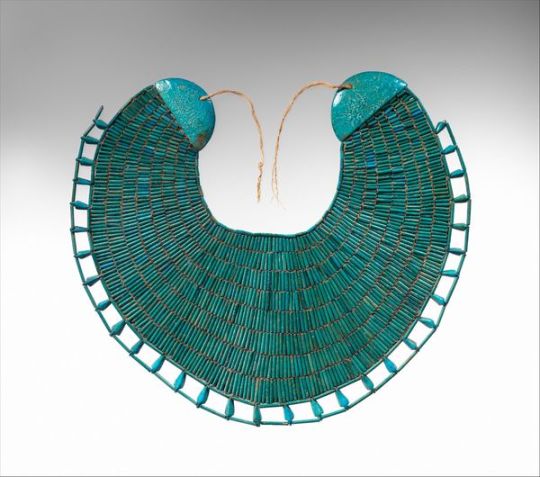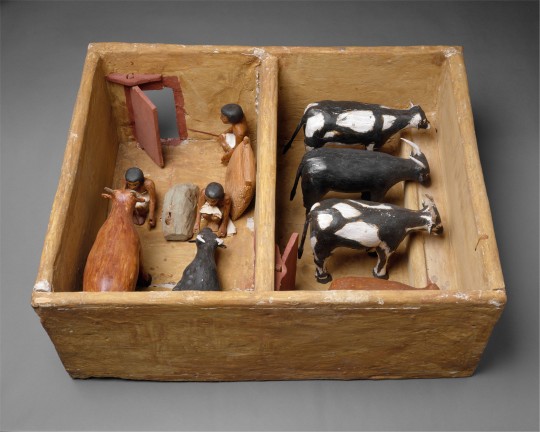#asasif
Explore tagged Tumblr posts
Text
https://english.ahram.org.eg/NewsContent/9/40/534510/Antiquities/Ancient-Egypt/st-Egyptian-Middle-Kingdom-era-tomb-uncovered-in-A.aspx
This is a wonderful find. It should be noted, though, that Asasif is a small-ish area on the West Bank at Luxor situated side-by-side with other small-ish areas. These other areas do contain quite a lot of early Middle Kingdom material, so this find's rarity is specific to Asasif.

12 notes
·
View notes
Text





Statuette of Wah - Met Museum Collection
Inventory Number: 20.3.210 Middle Kingdom, Dynasty 12, ca. 1981–1975 B.C. Location Information: From Egypt, Upper Egypt, Thebes, Southern Asasif, Tomb of Wah (MMA 1102), beside feet of mummy, MMA excavations, 1920
Description:
This statuette, intended to serve as a home for Wah's spirit, depicts a young man in the prime of life. Full of vigor, the little figure has the imposing presence of a much larger statue. The linen wrap may imitate the type of long skirt worn by Middle Kingdom officials. Beneath this, the figure wears the more typical short kilt, carved into the wood and painted white.
#Statuette of Wah#middle kingdom#dynasty 12#upper egypt#thebes#southern asasif#asasif#tomb of wah#met museum#20.3.210#mens clothing#MKMC
6 notes
·
View notes
Text

Joint US-Egypt Archaeology Team Unearths 4,000-Year-Old Tomb in Luxor
11 coffins for men, women and children found inside necropolis, suggesting it was a family tomb.
Archeologists from Egypt and the United States unearthed an ancient tomb with 11 sealed burials near the famed city of Luxor, Egyptian authorities said in a statement Friday.
Egypt’s Tourism and Antiquities Ministry said that the tomb, which dates back to the Middle Kingdom (1938 BCE-1630 BCE), was found in the South Asasif necropolis, next to the Temple of Hatshepsut on the Nile’s West Bank in Luxor.


The joint Egyptian-American mission excavating the necropolis found coffins for men, women and children, suggesting that it was a family tomb used for generations during the 12th Dynasty and the beginning of the 13th Dynasty, said Mohamed Ismail Khaled, Secretary-General of the Supreme Council of Antiquities in Egypt.
He said ancient floods destroyed most of the burials’ wooden coffins and linen wrappings.
However, some items such as jewelry in women’s burials were found intact, including a finely crafted necklace with 30 amethyst beads and two cylindrical agate beads framing a hippo-head amulet, according to the statement.


Katherine Blakeney, chief American archeologist with the South Asasif Conservation Project, said they found two copper mirrors, one with a lotus-shaped handle, and the second with a unique design of Hathor, goddess of the sky, women, fertility and love in ancient Egypt.
According to a statement from the South Asasif Conservation Project, directed by Dr. Elena Pischikova, this find is the first Middle Kingdom tomb found in the area.
The project’s statement referenced several finds, including a green-blue glazed faience fertility figurine with truncated legs, decorated with jewelry markings on the legs and torso, and a square-shaped offering tray with relief representations of a bull’s head, a loaf of bread and other offerings.
In the 11 discovered burials, team member Dr. Afaf Wahba identified the skeletons of five women, two men and three children. Six of the individuals — primary females — were interred with burial assemblages.



#Joint US-Egypt Archaeology Team Unearths 4000-Year-Old Tomb in Luxor#Temple of Hatshepsut#South Asasif necropolis#ancient necropolis#ancient grave#ancient tomb#ancient artifacts#archeology#archeolgst#history#history news#ancient history#ancient culture#ancient civilizations#ancient egypt#egyptian history#egyptian art#ancient art
126 notes
·
View notes
Text

Statuette of Wah
This statuette, intended to serve as a home for Wah's spirit, depicts a young man in the prime of life. Full of vigor, the little figure has the imposing presence of a much larger statue.
The linen wrap may imitate the type of long skirt worn by Middle Kingdom officials. Beneath this, the figure wears the more typical short kilt, carved into the wood and painted white.
Middle Kingdom, 12th Dynasty, reign of Amenemhat I, ca. 1981-1975 BC. From Tomb of Wah, Southern Asasif, Thebes. Now in the Metropolitan Museum of Art. 20.3.210
31 notes
·
View notes
Text


Model Bakery and Brewery from the Tomb of Meketre
Metropolitan Museum of Art, Egyptian Art Collection
On view at The Met Fifth Avenue in Gallery 105
Period: Middle Kingdom
Dynasty: Dynasty 12
Reign: reign of Amenemhat I, early
Date: ca. 1981–1975 B.C.
Geography: From Egypt, Upper Egypt, Thebes, Southern Asasif, Tomb of Meketre (TT 280, MMA 1101), serdab, MMA excavations, 1920
Medium: Wood, gesso, paint, linen
Dimensions: l. 73 cm (28 3/4 in); w. 55 cm (21 5/8 in); h. 29 cm (11 7/16 in) average height of figures: 21 cm (8 1/4 in.)
Credit Line: Rogers Fund and Edward S. Harkness Gift, 1920
Accession Number: 20.3.12
42 notes
·
View notes
Photo

Broad Collar of Wah.
Middle Kingdom, Dynasty 12, reign of Amenemhat I, early,
ca. 1981–1975 B.C. Upper Egypt, Thebes, Southern Asasif, Tomb of Wah (MMA 1102), Mummy, in wrappings on chest, MMA excavations, 1920.
Faience, linen thread.
Dimensions:H. 34.5 cm (13 9/16 in.); W. 39 cm (15 3/8 in.)The Met
22 notes
·
View notes
Text
youtube
"Exploring Egypt's Middle Kingdom at the Site of Ancient Thebes." Presentstion by Antonio J. Morales for Harvard Museum of the Ancient Near East in March, 2022, regarding work done at Deir al-Bahari and Asasif. English subtitles are provided in the settings.
1 note
·
View note
Text
Descoberta de Tumba Egípcia Revela Tesouros de Uma Família Nobre de 4.000 Anos
Em um dos maiores achados arqueológicos do Egito nos últimos tempos, uma equipe de cientistas revelou uma tumba de aproximadamente 4.000 anos, localizada na necrópole de South Asasif, na Cisjordânia de Luxor. A descoberta, que data do Império Médio (1938-1630 a.C.), oferece uma visão inédita sobre as práticas funerárias e a vida de uma família de alta classe social da época. O túmulo foi…
0 notes
Text
Arqueólogos Descobrem Tumba Egípcia Intocada com Esqueletos e Joias em Necrópole Antiga
Uma descoberta impressionante foi realizada na Necrópole de Al-Asasif, no Egito: uma tumba intocada, datada do Império Médio (1991 a.C. a 1649 a.C.), revelou um tesouro arqueológico com esqueletos, joias e artefatos preservados, apesar de uma enchente no local. Uma Relíquia do Império Médio A tumba, atribuída às 12ª e 13ª dinastias do Egito Antigo, permaneceu selada por milênios. De acordo com…
0 notes
Text
Descubren ataúdes egipcios con una colección de joyas del Imperio Medio
Publicado: 2 de noviembre de 2024 19:01 GMT Se espera que el hallazgo contribuya a comprender los rituales funerarios que se realizaban en Tebas durante esa época. Arqueólogos descubrieron la primera tumba del Imperio Medio (2040-1782 a. C.) en el cementerio Asasif Sur, en el marco de una misión arqueológica egipcio-estadounidense, realizada al oeste de la ciudad egipcia de Luxor. La…
0 notes
Photo
Model Cattle stable from the tomb of Meketre
Middle Kingdom, Dynasty 12, early reign of Amenemhat I, ca. 1981–1975 B.C.
From Egypt, Upper Egypt, Thebes, Southern Asasif, Tomb of Meketre (TT 280, MMA 1101), MMA excavations, 1920
Plastered and painted wood, gesso
Dimensions: l. 72.5 cm (28 9/16 in); w. 57 cm (22 7/16 in); h. 28.5 cm (11 1/4 in) average height of cattle: 18 cm (7 1/16 in.)
This model of a stable was found with twenty three other models of boats, gardens, and workshops in a hidden chamber at the side of the passage leading into the rock cut tomb of the royal chief steward Meketre, who began his career under King Nebhepetre Mentuhotep II of Dynasty 11 and continued to serve successive kings into the early years of Dynasty 12. Cattle are being fattened for slaughter in this stable. Four oxen feed from a manger in the large stall; two others are being hand fed by the stablemen from a pile of fodder and a sack of grain in the room in front. One of the cattle is so fat he can no longer stand. By the door sits an overseer with a baton in his hand. All the accessible rooms in the tomb of Meketre had been robbed and plundered already during Antiquity; but early in 1920 the Museum's excavator, Herbert Winlock, wanted to obtain an accurate floor plan of the tomb's layout for his map of the Eleventh Dynasty necropolis at Thebes and, therefore, had his workmen clean out the accumulated debris. It was during this cleaning operation that the small hidden chamber was discovered, filled with twenty-four almost perfectly preserved models. Eventually, half of these went to the Egyptian Museum, Cairo, and the other half came to the Metropolitan Museum in the partition of finds. Collection of the Metropolitan Museum of Art

Model cattle stable from the tomb of Meketre, 1981BC-1975BC, Thebes, Egypt.
195 notes
·
View notes
Link
I know I say this all the time, but this is truly an astonishing find. These are absolutely beautiful and the condition is amazing, although one doesn’t expect anything less in Egypt’s climate. I wonder if these are a cache waiting for occupants or whether they have occupants already. We’ll find out soon enough, I guess. EDIT: This talk, apparently, that this is a dump of sorts from a late 19th-early 20th century excavation, something similar. In other words, these coffins are not unknown. Part of the reason for thinking this is the stacking of the coffins. And there are remains in several, if not all. 
#ancient Egypt#archaeology#Egyptian coffins#Asasif#Luxor#coffin cache#University of Auckland#Classical Studies and Ancient History
9 notes
·
View notes
Photo

Escarabajo del capataz supervisor de Wah. Plata, electro, esteatita esmaltada, cordón de lino. Tumba de Wah, sur de Asasif, Tebas, Alto Egipto. Dinastía Media, principios del reino 12.º (Amenemhat I), ca 1981-1975 a. de C.
3 notes
·
View notes
Text


Game of Hounds and Jackals
Metropolitan Museum of Art, Egyptian Art Collection
On view at The Met Fifth Avenue in Gallery 111
Period: Middle Kingdom
Dynasty: Dynasty 12
Reign: reign of Amenemhat IV
Date: ca. 1814–1805 B.C.
Geography: From Egypt, Upper Egypt, Thebes, Asasif, Birabi, pit tomb CC 25, debris, Carnarvon/Carter excavations, 1910
Medium: Ebony, ivory
Dimensions: Board: H. 6.8 cm (2 11/16 in.); W. 10.1 cm (4 in.); D. 15.6 cm (6 1/8 in.); Average height with pins: 14 cm (5 1/2 in.); Jackal pins: H. 7 cm (2 3/4 in.) to 8.5 cm (3 3/8 in.) Bottom (2012.508): L. 12.9 cm (5 1/16 in); W. 7.4 cm (2 15/16 in); Th. 0.3 cm (1/8 in); Hound pins: H. 6 cm (2 3/8 in.) to 6.8 cm (2 11/16 in.)
Accession Number: 26.7.1287a–k
3 notes
·
View notes
Photo

Kohl jar
ca. 2030–1640 B.C.
View full size image
#Pottery: reddish-brown ware#Middle Kingdom#From Egypt#Upper Egypt#Thebes#Asasif#MMA excavations#1915–16
1 note
·
View note
Photo

god Atum and Pharaoh Hatshepsut, from Lower Asasif from the Hatshepsut Valley Temple
#Atum#Hatshepsut#Lower Asasif#Egypt#Ancient Egypt#Hatshepsut Valley temple#archeology#ancient history
94 notes
·
View notes